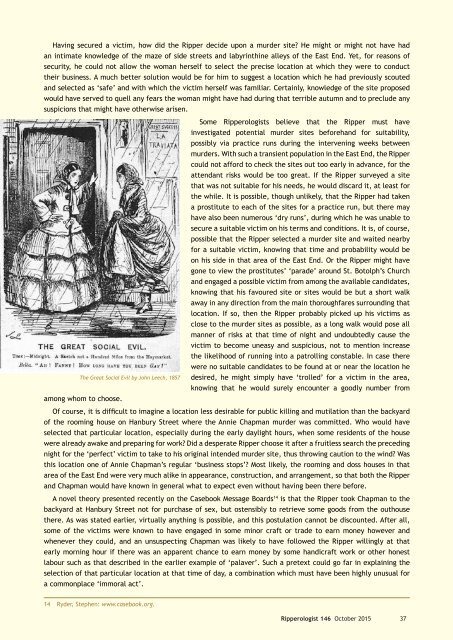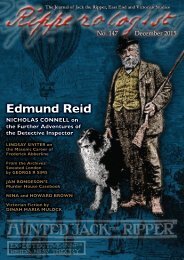GEORGE HUTCHINSON
orxwju5
orxwju5
Create successful ePaper yourself
Turn your PDF publications into a flip-book with our unique Google optimized e-Paper software.
Having secured a victim, how did the Ripper decide upon a murder site? He might or might not have had<br />
an intimate knowledge of the maze of side streets and labyrinthine alleys of the East End. Yet, for reasons of<br />
security, he could not allow the woman herself to select the precise location at which they were to conduct<br />
their business. A much better solution would be for him to suggest a location which he had previously scouted<br />
and selected as ‘safe’ and with which the victim herself was familiar. Certainly, knowledge of the site proposed<br />
would have served to quell any fears the woman might have had during that terrible autumn and to preclude any<br />
suspicions that might have otherwise arisen.<br />
The Great Social Evil by John Leech, 1857<br />
among whom to choose.<br />
Some Ripperologists believe that the Ripper must have<br />
investigated potential murder sites beforehand for suitability,<br />
possibly via practice runs during the intervening weeks between<br />
murders. With such a transient population in the East End, the Ripper<br />
could not afford to check the sites out too early in advance, for the<br />
attendant risks would be too great. If the Ripper surveyed a site<br />
that was not suitable for his needs, he would discard it, at least for<br />
the while. It is possible, though unlikely, that the Ripper had taken<br />
a prostitute to each of the sites for a practice run, but there may<br />
have also been numerous ‘dry runs’, during which he was unable to<br />
secure a suitable victim on his terms and conditions. It is, of course,<br />
possible that the Ripper selected a murder site and waited nearby<br />
for a suitable victim, knowing that time and probability would be<br />
on his side in that area of the East End. Or the Ripper might have<br />
gone to view the prostitutes’ ‘parade’ around St. Botolph’s Church<br />
and engaged a possible victim from among the available candidates,<br />
knowing that his favoured site or sites would be but a short walk<br />
away in any direction from the main thoroughfares surrounding that<br />
location. If so, then the Ripper probably picked up his victims as<br />
close to the murder sites as possible, as a long walk would pose all<br />
manner of risks at that time of night and undoubtedly cause the<br />
victim to become uneasy and suspicious, not to mention increase<br />
the likelihood of running into a patrolling constable. In case there<br />
were no suitable candidates to be found at or near the location he<br />
desired, he might simply have ‘trolled’ for a victim in the area,<br />
knowing that he would surely encounter a goodly number from<br />
Of course, it is difficult to imagine a location less desirable for public killing and mutilation than the backyard<br />
of the rooming house on Hanbury Street where the Annie Chapman murder was committed. Who would have<br />
selected that particular location, especially during the early daylight hours, when some residents of the house<br />
were already awake and preparing for work? Did a desperate Ripper choose it after a fruitless search the preceding<br />
night for the ‘perfect’ victim to take to his original intended murder site, thus throwing caution to the wind? Was<br />
this location one of Annie Chapman’s regular ‘business stops’? Most likely, the rooming and doss houses in that<br />
area of the East End were very much alike in appearance, construction, and arrangement, so that both the Ripper<br />
and Chapman would have known in general what to expect even without having been there before.<br />
A novel theory presented recently on the Casebook Message Boards 14 is that the Ripper took Chapman to the<br />
backyard at Hanbury Street not for purchase of sex, but ostensibly to retrieve some goods from the outhouse<br />
there. As was stated earlier, virtually anything is possible, and this postulation cannot be discounted. After all,<br />
some of the victims were known to have engaged in some minor craft or trade to earn money however and<br />
whenever they could, and an unsuspecting Chapman was likely to have followed the Ripper willingly at that<br />
early morning hour if there was an apparent chance to earn money by some handicraft work or other honest<br />
labour such as that described in the earlier example of ‘palaver’. Such a pretext could go far in explaining the<br />
selection of that particular location at that time of day, a combination which must have been highly unusual for<br />
a commonplace ‘immoral act’.<br />
14 Ryder, Stephen: www.casebook.org.<br />
Ripperologist 146 October 2015 37




